#schlag metal leaf
Photo




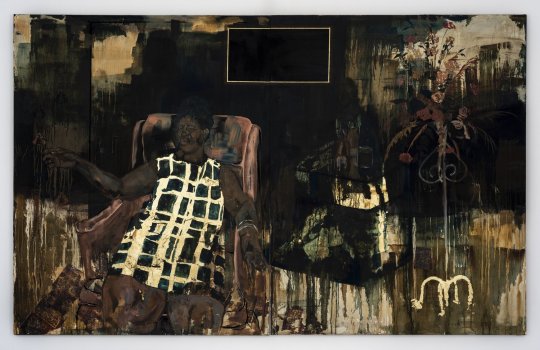

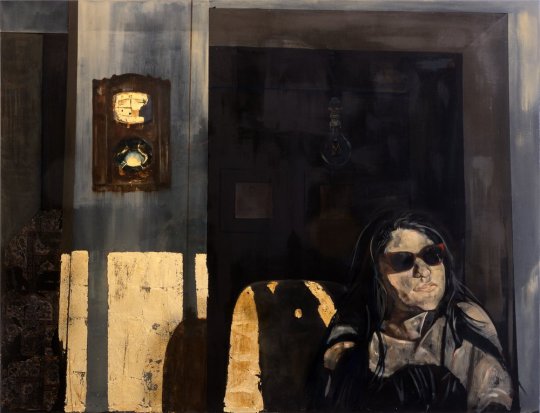

Emma Prempeh b. 1996 is a British artist with Ghanaian and Vincentian heritage based in London.
The tonal properties of her paintings enjoy warm, darkened earthly tones with a strong presence of blackness to invoke and project memories of events, people, and places that emphasise her appreciation of ancestral time and relationships, selfhood and transformation. Prempeh occasionally experiments with projected still and moving imagery to create painting installations that invite other experiential and performative encounters with her work. Embedded within her canvasses are hints of schlag metal, a brass alloy of copper and zinc imitative of gold leaf, representative of the exploration into the transitional journey between life and death. Over time, the material deteriorates, suggestive of the ineluctable passing of time.
Prempeh Studied at Goldsmiths University of London graduating in 2019 winning the Alumno/Space bursary award for 2020. She won 1st place for the Ingram Collection Purchase Prize and became a participating artist in Bloomberg New contemporaries 2019. Prempeh recently attended MA Painting at the Royal College of Art under the LeverHulme Trust Arts Scholarship winning the Valerie Beston Trust Arts award for 2022.
https://emmaprempeh.com/
39 notes
·
View notes
Text

found object mirror cover fitted to slate - w.i.p. - schlag metal leafing with verdigris patina #4
7 notes
·
View notes
Photo
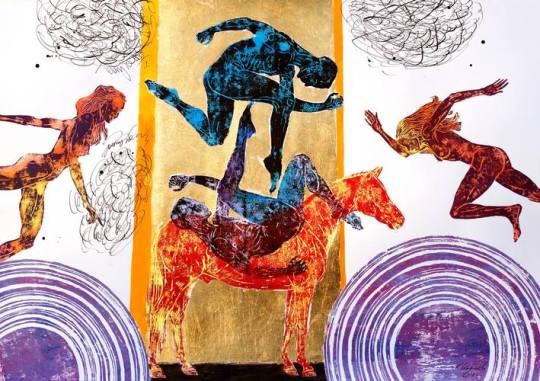
Red horse - from the series Platonic Solids, Katarzyna Kopanska
From the series "Platonic Solids" "Platonic Solids" is my largest series. On some works there appear characters dancing in ritual, dynamic poses. They are beyond gravitation, in a fight, in motion. Other works depict figures siting thoughtfully, that is why, some works in that series are subtitled Contemplatio. That series was inspired by real Platonic solids, i.e., regular polyhedrons. I use to make drawings and all kinds of figures that enrich mathematical and philosophical papers of my husband. In this way I have learned that these polyhedrons constitute elements in Plato’s cosmology. Thus the tetrahedron is associated with fire, the cube with earth, the octahedron with air, the icosahedron with water. The mysterious dodecahedron, probably unknown to Plato, in Greek tradition, was associated with the Universe. About my technique These are works on paper. It is usually chalk overlay paper or textured paper. I prefer, however, the former, since it enables me to press linocuts one over another to make a graphic layered structure. I can also scratch it to add new textural effects. As for colors, I use acrylic paints, watercolors, crayons, inks, and schlag metal (red gold leaf) + shellac varnish.
https://www.saatchiart.com/art/Painting-Red-horse-from-the-series-Platonic-Solids/299059/3532849/view
1 note
·
View note
Text

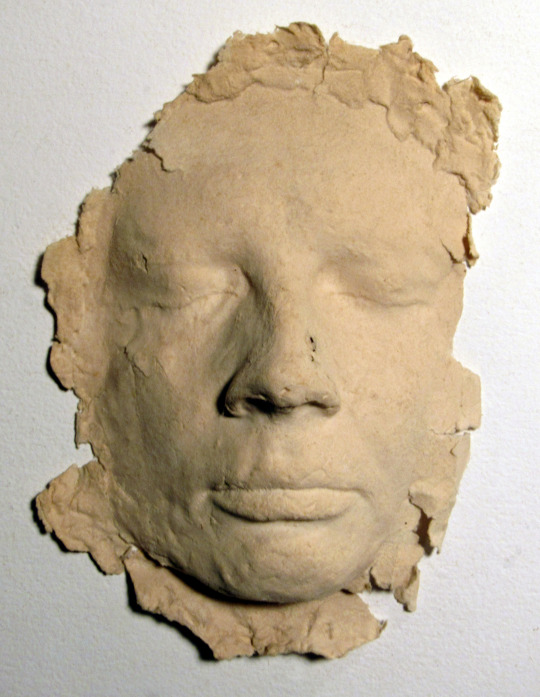


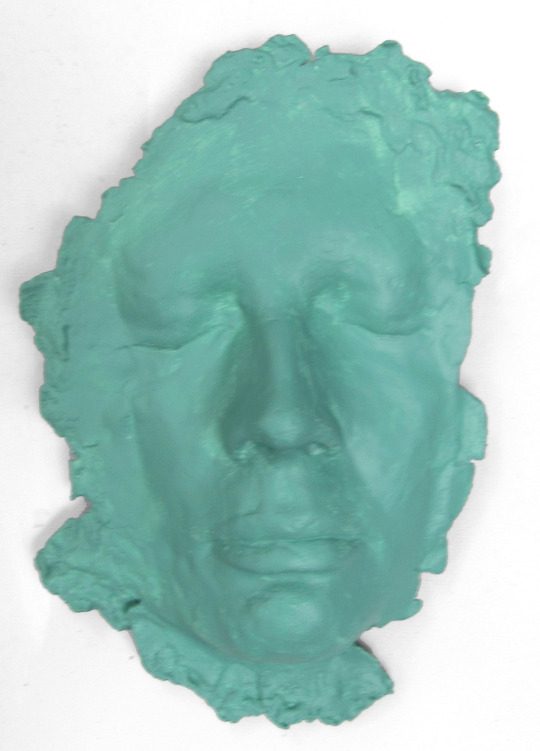
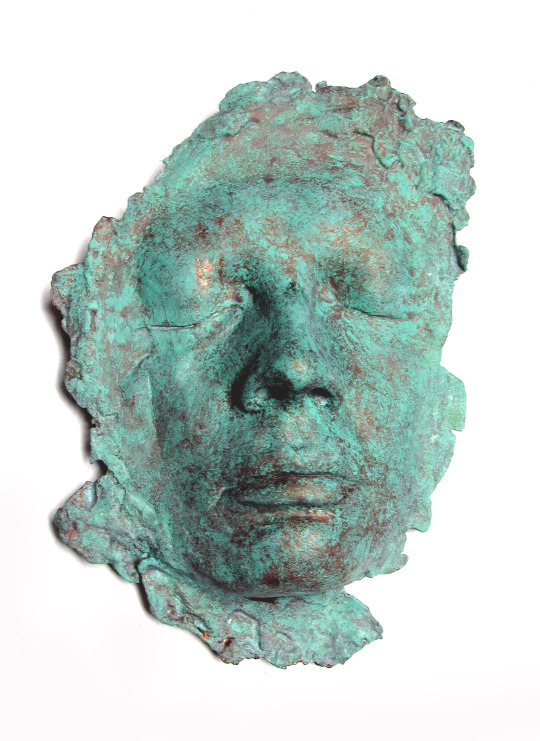
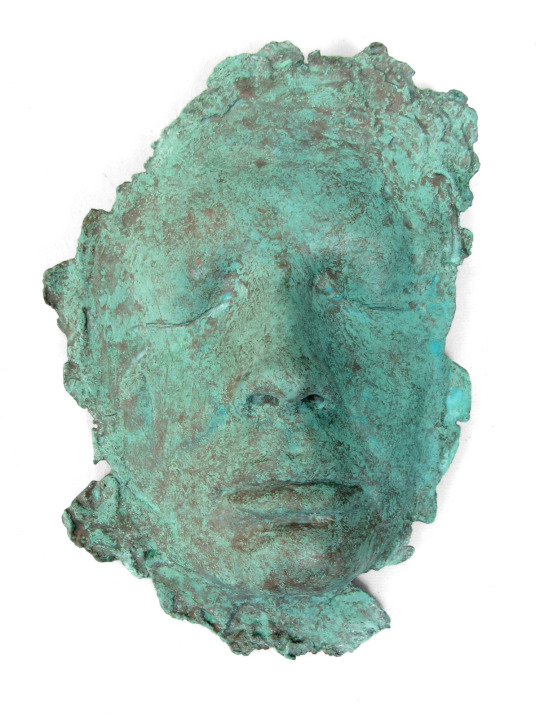

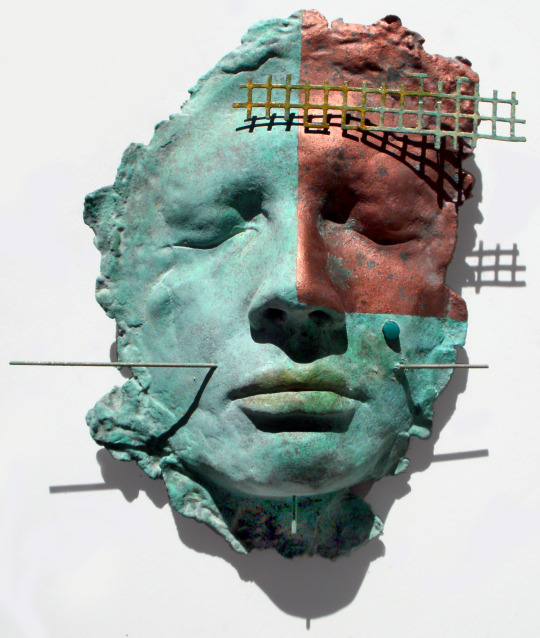

THE LONG WAY HOME
handmade & handcast paper, acrylic base coat, german silver, schag metal leafing, patina chemicals, steel, bronze powder, green glass, lacquer, pigment, wood, glass
THE LONG WAY HOME w.i.p. stages:
w.i.p. state 1 - handmade cast paper
w.i.p. state 4 - handmade cast paper, gesso 1st coat
w.i.p. state 7 - handmade cast paper, gesso coat seven
w.i.p. state 8- handmade cast paper, acrylic base coat
w.i.p. state 10 - handmade cast paper, bronze powder, with green patina chemical applied
w.i.p. state 11 - handmade cast paper, bronze powder, with blue patina chemical applied
w.i.p. state 12 - handmade cast paper, german silver rods added, schlag metal leafing applied with green patina chemical sprayed-on
w.i.p. state 17 - handmade cast paper, bronze powder applied with spatterings of blue patina chemical, green glass rod fitted, gilt steel grid with green patina spattered and fitted, transparent yellow lacquer applied to part of grid and lips
THE LONG WAY HOME - fitted to shadowbox, green glass rods fitted to frame, sandblasting of frame and of glass - 11"x 9" x 2¾" as framed
15 notes
·
View notes
Text






Jeriles' mask revised
3D printed plastic found object (heat-formed modification), polyester resin, copper wire, paint, schlag-metal leaf, chemical patinas, wash
w.i.p. stages:
stage 2 - after heat forming and multiple filling and sanding to get the surface re-contoured (five hours of work)
stage 4 - two layers of leafing
stage 7 - three applications of chemical patinas applied
stage 9 - sealed and washed
stage 11 - rectilinear area leafed
stage 13 - chemical patina applied, sealed with clear matte acrylic
Purchased painted 3D printed mask from Jeriles and ordering another one unfinished so I could fit to my face (this one was too small to fit my face) and finish to suit. Photographed and posted on social media (Tumblr) as he requested, and he was supposed to email me — but I never heard from Jeriles again.
Six½ months later decided I was going to re-fit the mask so I could wear it, and then decided I would also refinish it. Five hours work to re-fit the mask (using heat forming) and to then re-contour and re-surface the mask to remove the textures left by the 3D printing process. This work included re-doing the back areas for attaching the ribbons for wearing by cutting-away an inch or so of the original holed tabs, fitting loops of copper wire, and filling the contours with Bondo.
When the form and surfaces were properly contoured the front surface of the mask was sized with fast-set and the schlag metal leafing applied. 24 hours later another layer of size and leafing was applied. Another 24 hours the front was lightly sprayed with a diluted PatinaGreen (1 part PG to 4 parts H2O). 24 hours later the spraying was repeated, and about 4 hours later a light spraying of full-strength PatinaBlue was applied.
The following day an application of 1/4-strength PatinaGreen was brushed-on. A few hours later a sprayed-on application of full-strength PatinaBlue was applied.
The following day an application of clear acrylic matte sealer was sprayed-on.
24 hours later a light greyish-green acrylic wash was applied (wiped), followed in five hours by several coats of clear acrylic.
Twenty-four hours later a rectilinear area was leafed, following the next day with a full-strength PatinaBlue. The work was sealed with an acrylic matte finish. The only thing left to finish is attaching the two cloth ribbons so it can be worn — necessitating a trip to the store as I only had half enough ribbon in the studio.
17 notes
·
View notes
Text
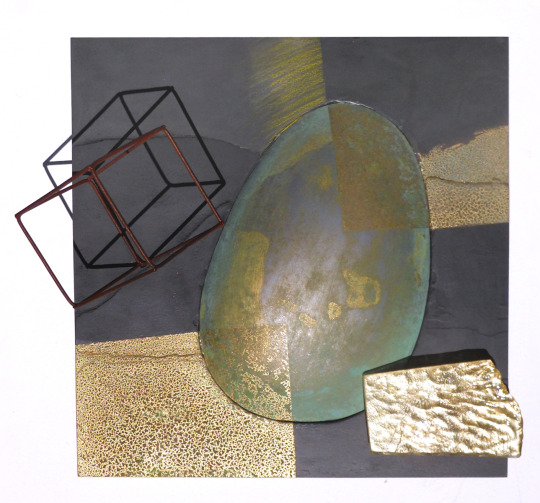

Bump in the Night (Early January)
Connemara slate, found object, schlag metal leafing with verdigris patina, rippled glass with leafing, painted steel wire found object, colored pencil
11⅞"x 13½"x 5½"
For forty-six years we've lived in a house on the outside curve of the road and over that time we've had over a dozen car wrecks in the front yard. Most of the collisions are hit and run, with the vehicle leaving before we can even get to the window and see what caused the noise. This piece began one morning early in the year with finding a broken object and shards of mirror in the slightly torn-up grass by the utility pole at the end of the driveway — small evidence of the most recent bump in the night.
2 notes
·
View notes
Text



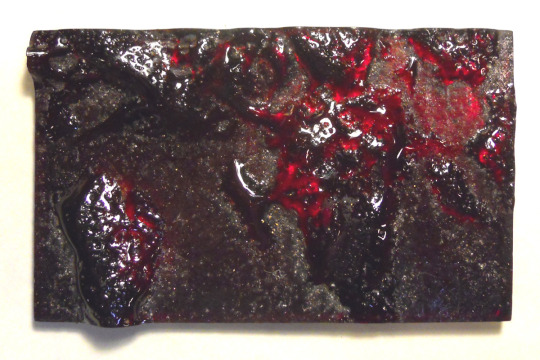
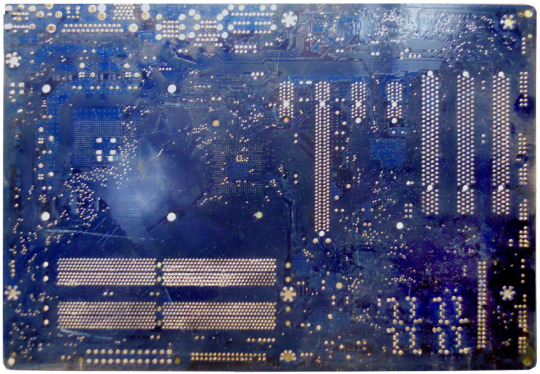
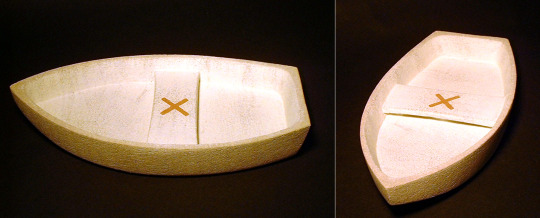
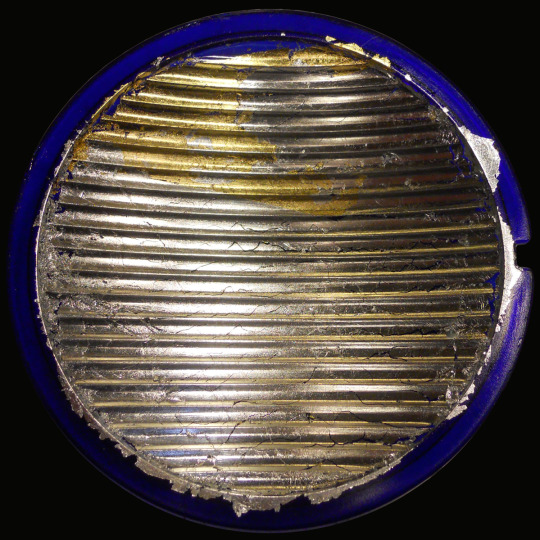

w.i.p. elements currently being worked:
rippled clear glass with schlag metal & aluminum leafing on reverse - 7⅝" wide
rippled clear glass with schlag metal leafing on reverse (offcut from listing above) - 4" wide
pink steatite egg - 2⅛" high
slumped transparent red glass, leafed with aluminum on reverse - 4¼" wide
circuit board from a dead HP studio computer - 12" wide
limestone dory with pigmented polyester resin 'X' (two views) - 10" long
transparent blue glass lighting lens with ridges, leafed with aluminum & schlag metal - 5½" diameter
cast plastic resin skull with aged finish - 1¼" high
#sculpture#glass#leafing#w.i.p.#limestone#circuit board#steatite#plastic resin#skull#boat#slumped glass
3 notes
·
View notes
Photo

Long Lips (W.I.P. title) being leafed, session #2
#art by me#my artwork#sculpture#lips#W.I.P.#imitation gold leaf#schlag metal leaf#plaster#Don Dougan
4 notes
·
View notes
Photo



BREAKING UP: LIPQUAKE - cast & carved plaster, metal leaf, black faux suede shadowbox, wood, glass, paint - 9½"x 10"x 2¼"
This unique piece came about after the larger, rectangular cast broke. I then deliberately broke the casting into a smaller irregular shape and then carved the irregular ridges into what had been an uniformly smooth surface. Leafed it and then applied a light gray wash.
#my artwork#art by me#lips#Don Dougan#shadowbox#Lipquake#unique#schlag metal leaf#metal leafing#washed
3 notes
·
View notes
Photo



THE CENTER HOLDS - cast & carved plaster, aluminum leaf, paint, gray faux suede, carved wood, glass - 8¼"x 11"x 2½"
This unique piece came about from the fact that I was not happy with the original design modeled in plasticene from which a mold was cast. There were two plaster positives cast from that original mold, each finished differently but using the textures and edges mimicking a patchwork quilt. I was so unhappy with the results that I re-worked the negative mold using a woodcarving gouge to carve a radial pattern moving outwards from the lips. I cut the mold down into a smaller rectangle; from which I cast three positives: one in plaster, another in red earthenware, and a third in black stoneware. The red earthenware version was mounted on dark stone. This version was leafed with aluminum and washed in a yellow ocher. The front surface of the frame was carved with a grinder to echo the radial pattern, sanded smooth, painted black and then leafed in aluminum, followed by a cream wash. Front surface of the frame was lightly rubbed to reveal black base coat.
2 notes
·
View notes
Photo

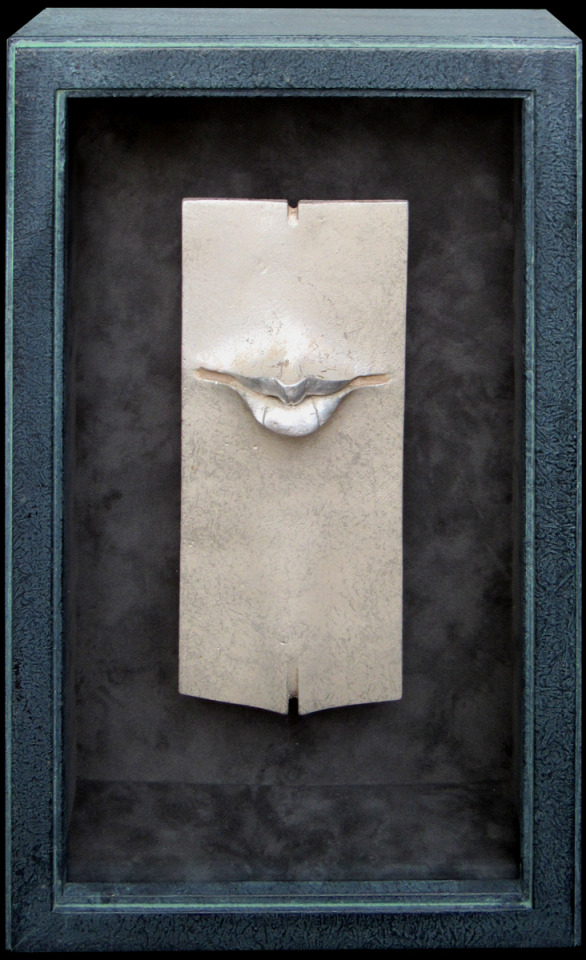
MECCANIKA TRANSFORMED: ALUMINATION - cast & carved plaster, aluminum leaf, gray faux suede shadowbox, wood, glass, paint - 12"x 7¾"x 2½"
This unique piece came about because the surface texture of the casting was marred by several air bubbles breaking-up the linear pattern. Solution: carve away surface texture and make the surface smooth leaving traces of the original pattern at top and bottom. The lower lip texture is unchanged from the original design. The original design was cast in several materials: plaster, dental stone, Vatican casting stone, and hand made paper pulp. All of these were titled as variations on Meccanika — hence the title Meccanika Transformed.
#my artwork#art by me#lips#sculpture#shadowbox#Don Dougan#Meccanika Transformed#unique#schlag metal leaf#metal leafing#washed
4 notes
·
View notes
Photo

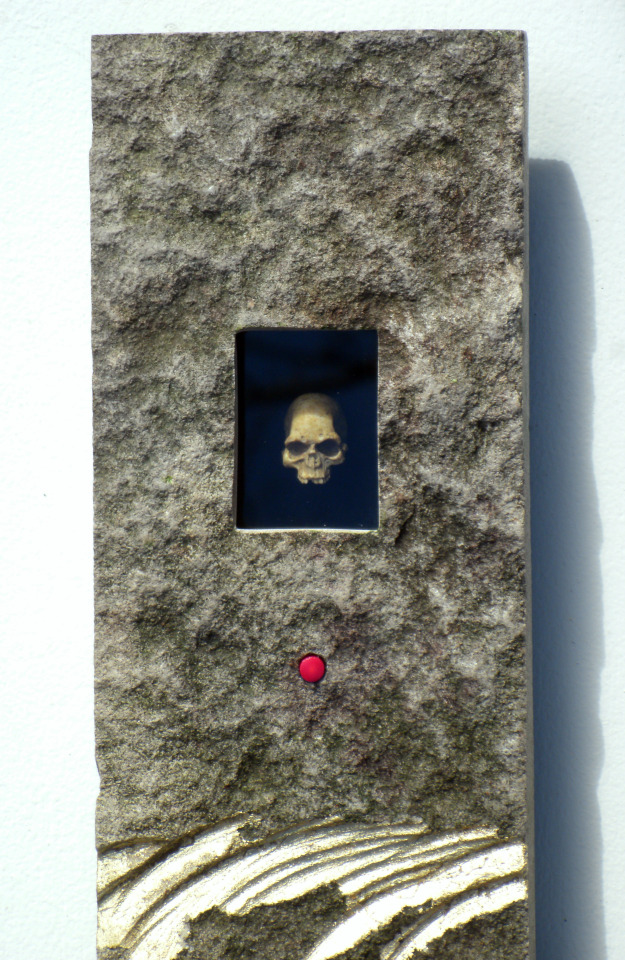

INTIMATIONS OF MORTALITY
Indiana limestone, clear and colored glass, found object (plastic skull), gold leaf, black suede matboard - 14"x 4⅛"x 1⅞"
This piece was a quick one. Just before Christmas break the Gallery Committee at school decided to have an exhibit in one of the smaller Galleries in early January. The call went out on December 18 for the exhibit POSTCARDS FROM THE WINDOW (originally the title was to be POSTCARDS FROM THE LIVING ROOM). The theme was for works done on thoughts during the quarantine. The size restrictions were that all works were to be no larger than 11″ x 14″.
Though a few days were used to think about possible approaches to the design, this took only three days to make after I had decided upon the found object focal point of the design — from the 27th through the 29th of December. The found object focal point was the little skull which I have had for twenty years or so — it was originally the fob on a key chain, but I had cut it off the chain and it has been sitting by my computer up until now as a sort of mascot (I like skeletons & skulls <grin>). The shadow box was cut into the piece of limestone, glazed, then lined with suede black matboard. The natural patina on the porous limestone is what occurs in a matter of months in the southeast US where there is high humidity almost year-round — algae grows on the stone surface which makes for a very intense bright green when wet but turns a lighter grayish color when the stone is dry. To create a vertical gradation I lightly buffed away some of the patina on the upper portions of the dry limestone with something like Scotch-Brite to lighten and reveal some of the light coloring of the limestone below, but leaving the lower half of the limestone untouched. I used a diamond grinder to cut the zig-zag mark in the lower half, which I then leafed with schlag metal gold leaf. This was sealed to keep it bright. The end of the piece of red glass rod was polished and fitted into the limestone so it is just barely proud of the surface.
The title came as I was finishing the piece, speaking to the theme of (some) of what I have been thinking or feeling during our social-distancing quarantine.
#my artwork#art by me#sculpture#wall sculpture#Don Dougan#stone#limestone#found objects#gold leaf#schlag metal leaf#shadowbox#skull#patina#natural patina#glass#red glass
13 notes
·
View notes
Photo




GUYED FORM: RELUCTANT
slate, glazed porcelain, plastic, alabaster, metal leaf, brass, copper wire, verdigris patina, pigment - 13⅝"x 13"x 2¾"
This piece was a slow one: first work done in October and worked-on the next two months and getting finished just before Christmas. It piece began with the lid of a toilet seat which was being replaced. I cut it down and joined two curved symmetrical edges together. It was a pure unadulterated white which I was planning on using in some sort of vertical symmetrical design. Meanwhile, I had fitted the glazed porcelain to a piece of slate which I thought I might use. However, a few nights later I dreamed of the form as being finished in a green verdigris and fitted to a piece of black slate. So that is what I did — the form was leafed with two layers of schlag metal and given the patina. Originally it was fitted perpendicular to the slate, but after looking at it a few days I came back and spent a second hour or so re-fitting it so it appeared to be leaning at an angle. The guy wires were from another dream about leaning. The sandblasted arc and the red-lacquered alabaster were the final elements to be added. As usual the title was the last thing to finish it. The first selected title was THE RELUCTANT BRIDE, but that seemed too explicit — I decided the guy wires needed a mention and the term ‘reluctant‘ would suggest the idea of a character without being quite so specific. Good titles suggest rather than spell-out.
#art by me#my artwork#Don Dougan#sculpture#wall sculpture#stone#slate#alabaster#metal leaf#lacquer#copper#brass#grommet#wire#verdigris patina#found object#schlag metal leaf
2 notes
·
View notes
Photo
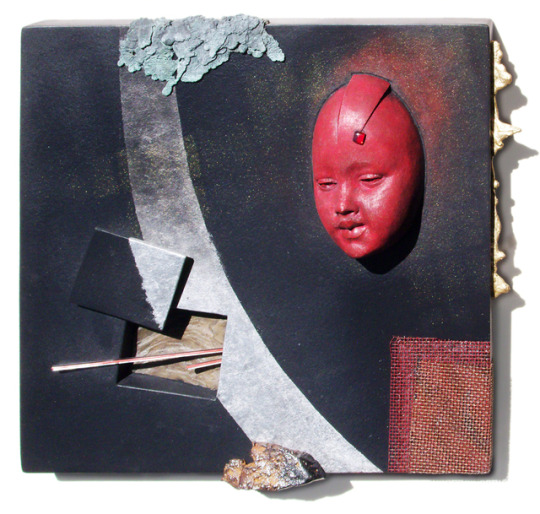

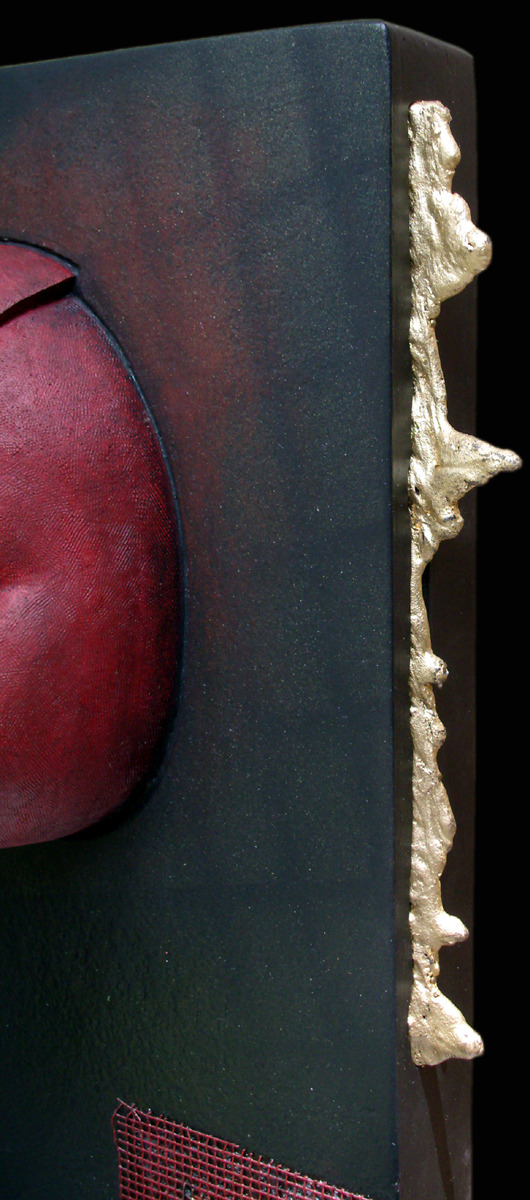




Dance of the Fourth Sister
ceramical, pietra serena sandstone, cast bronze, glass, Missouri hematite, steel, aluminum & schlag leafing, spray paint, latex paint on wood panel
18¾"x 20¼"x 4¼"
This piece began as a potential collaborative work, but as the first two elements were fitted to the black cradle — the cast and carved ceramical face and the recessed pietra serena — the news came that the other artist was backing out of the collaboration. With work begun I felt I needed to continue as if I were the other collaborator. Not as if I was the specific other artist (a painter), but as a new artist responding to the work my earlier self had suggested. The other elements were added and fitted as if the cradle, face and the stone recess were givens instead of starting points — I was now collaborating with my earlier self, trying to respond the tentative or unclear first forays into form that other self had fabricated without specific intent or meaning. The piece became a fragmented dialog between the earlier me and the later me.
six detail views:
cast and carved ceramical face with paint and red glass inlay fitted into cradle
schlag metal leafed steel ripple fitted to right edge of cradle
cast bronze spill fitted to top edge of cradle, verdigris patina
glass rods and pietra serena sandstone fitted in recess of cradle
partially polished Missouri hematite fitted on cradle bottom edge, aluminum leafing
painted ⅛" mesh hardware cloth fitted to bottom right of cradle
#my art#sculpture#collaboration#sculptural painting#sandstone#ceramical#cast bronze#glass#hematite#steel#aluminum leaf#schlag metal leaf#hardware cloth#paint#wood cradle#Don Dougan#artwork by me
6 notes
·
View notes
Photo


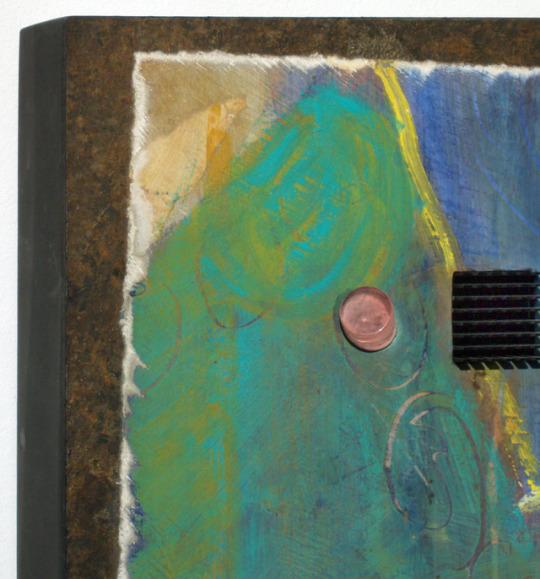
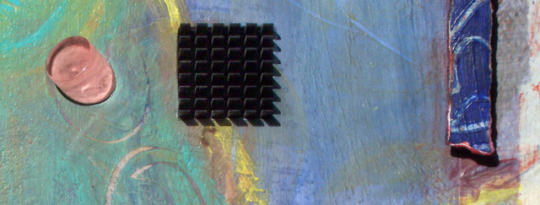


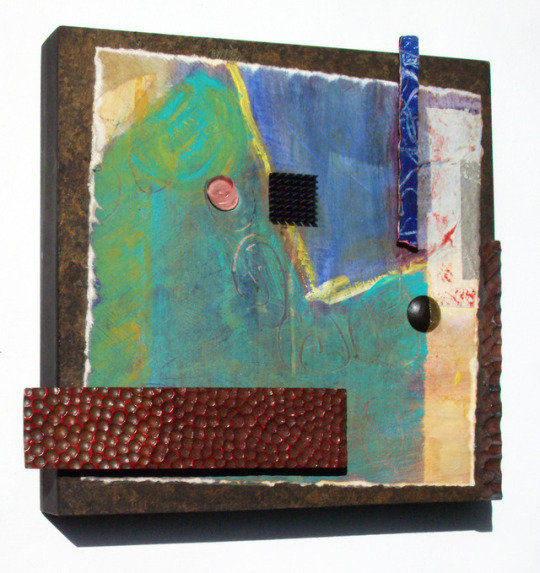
THAR SHE GOES!
Sculptural painting: oil on paper collage on wood cradle with found metal objects, walnut, plaster, acrylic, gold leaf, paint and pigments
11⅛"x 11½"x 2½"
Sometimes you find the most interesting things in trash cans. Especially at the end of semester in the painting studio across the hall. Torn-up pieces of paintings on paper were the genesis of this and another piece.
#my artwork#artwork by me#sculpture#sculptural painting#assemblage#oils#collage#paper#wood#found objects#gold leaf#schlag metal#acrylic plastic#plaster#steel#aluminum#Atlanta
1 note
·
View note
Photo


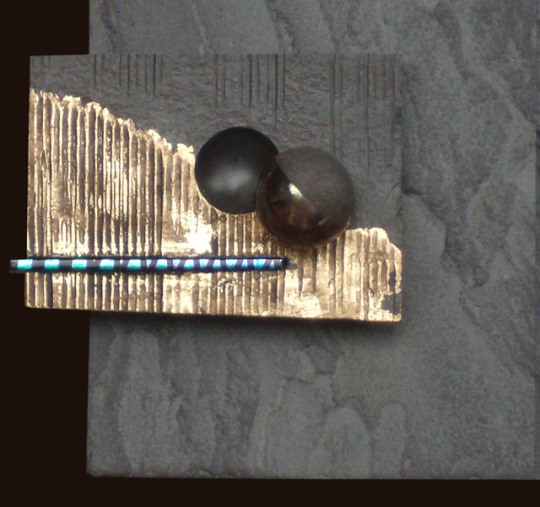
MIDSUMMER NIGHT’S DREAM: PENSÈE
Virginia slate, found objects (plastic gas can and spelter foliage), glass marble, dichroic glass rod, black glass rod, schlag metal leafing, pigment wash, sandblasting
12″x 13¼”x 1¾”
Cleaning up the studio just after the solstice and found an plastic old gas can without any cap or spout. Thought I might use the bottom of it as a drilling container for water when using diamond bits on small bits of lapidary or glass so I cut it open — throwing all the scrap into the recycling bin. Discovered the bottom wasn’t smooth or regular enough for that purpose when I got into it, but the subtle forms of the injection blow-molded interior were visually interesting so I cut it into a slab. About the same time a customer brought in a ‘married’ antique spelter electrified candelabra lamp that had been damaged. Late 19th century figure of a draped young woman titled ‘La Pensée’ with an outspread arm holding a torch to which had been added at a later date a fancy candelabra with five lamps. The arm had broken and been repaired at least once before, and the four-armed candelabra suspended from the torch was broken in several places — wiring just hanging loose. Because of the damage to the electrical parts and because it was a ‘married’ piece he said just fix the spelter figure’s arm and make the torch so it would hold a candle, and throw the rest away. So I am fixing the arm and re-doing the patina, but before throwing the waste bits into the recycle bin I cut the foliage decorations off the candelabra parts, of which this is least-damaged one of four.
The idea of contrasting the soft contours of the matte red plastic with the cleft black slate intrigued me, and the spelter foliage added a ‘historical’ element to the expression. The surface-mounted black slate rectangle at bottom left is the reversed waste ‘cut-out’ of the inlay fitting for the gas-can piece, to which I’ve added a little bit of leafing and the two glass elements to balance the composition. The parallel grooves on the surface are over the entire back side of the slate ‘tile’ to make the slate more-or-less ‘level’ when used as flooring.
#sculpture#wall sculpture#my artwork#Artwork by me#slate#stone#found objects#glass#gold leaf#Atlanta
3 notes
·
View notes